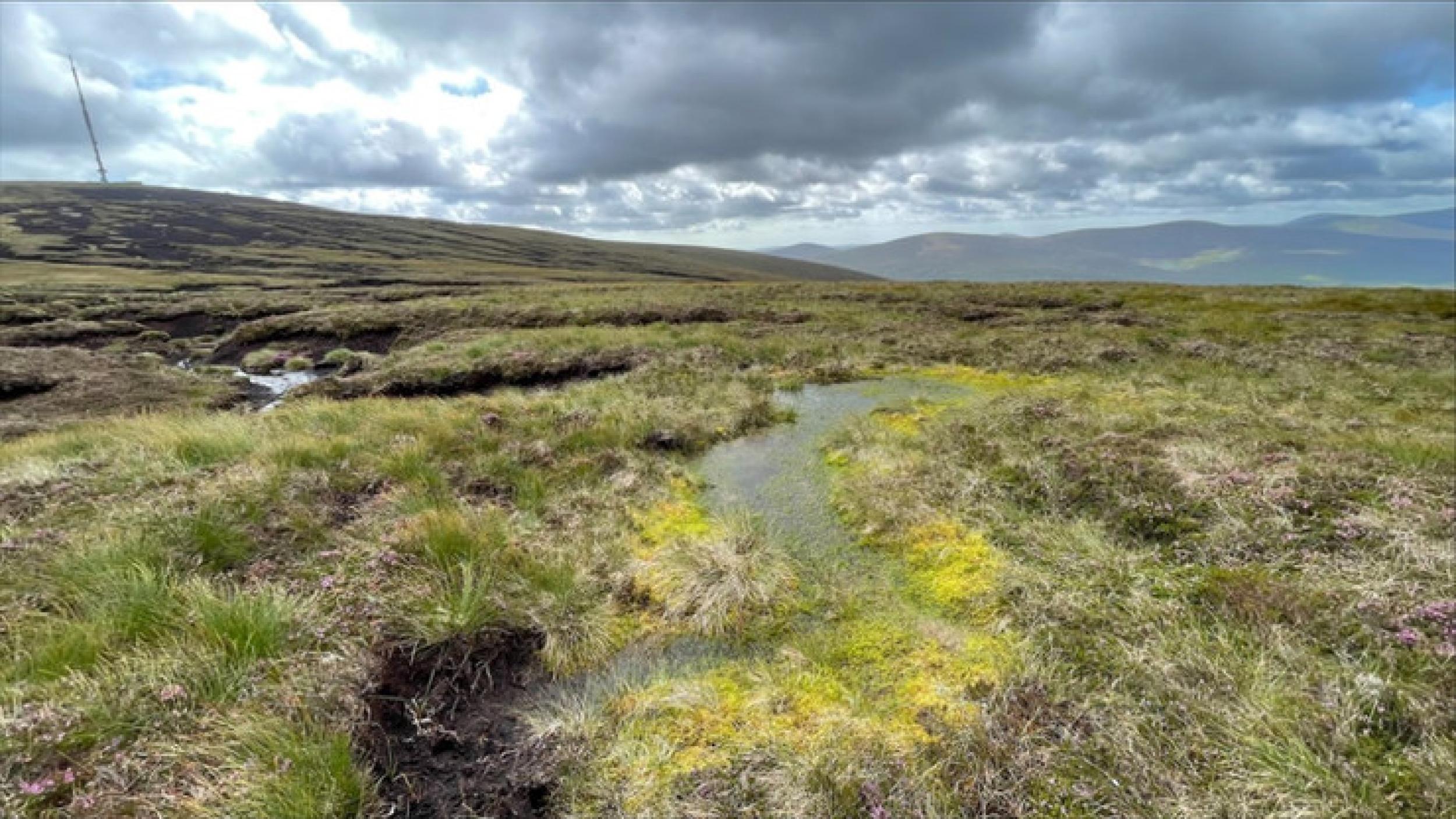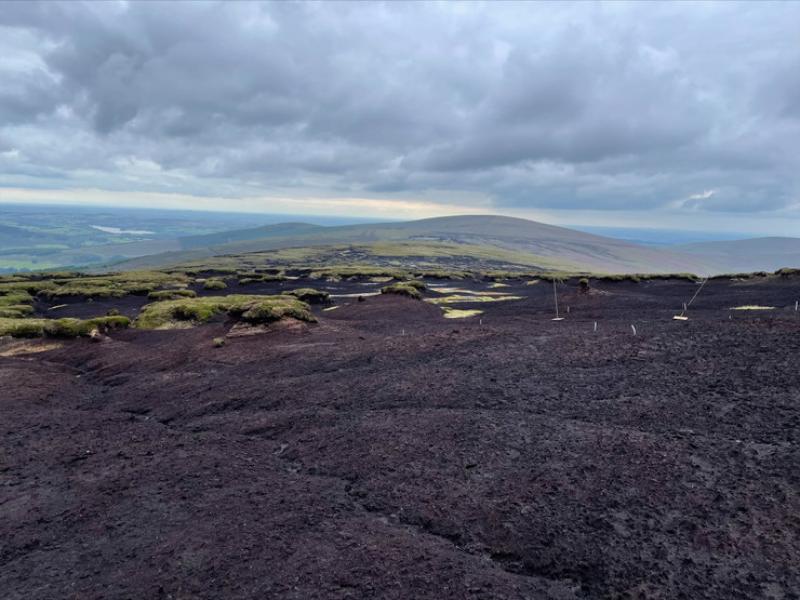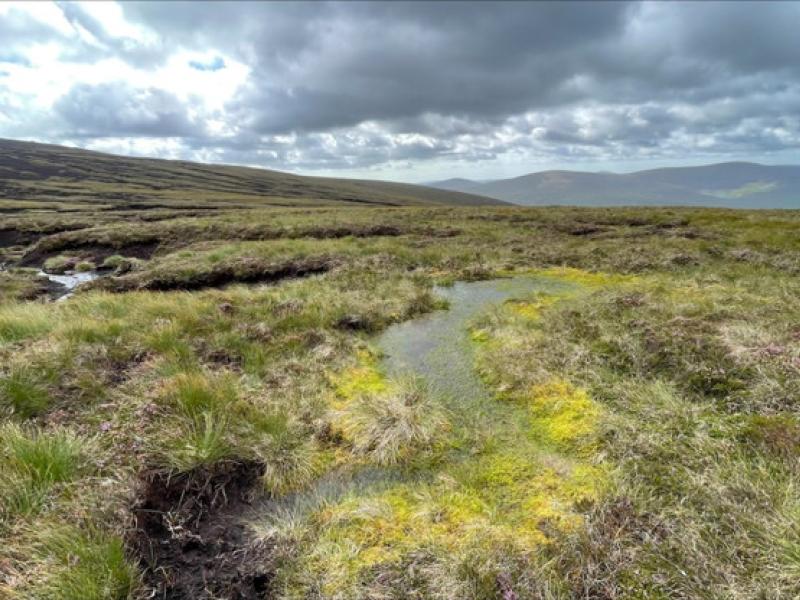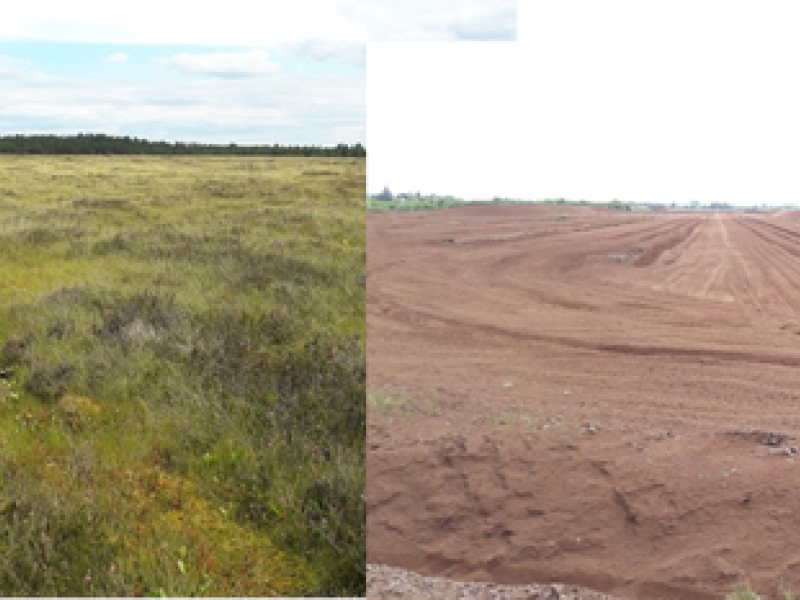
A Tale of Two Peatland Papers…
“It was the best of peatlands, it was the worst of peatlands, it was the UN Decade on Ecosystem Restoration, it was the Peatlands Gathering 2021, it was a Peatland Pavilion, it was a grand soft (bog) day…” Catherine Farrell, 2022.
Peatlands are in the news, for lots of reasons. Long cited as the Cinderella habitat, in past times peatlands have been sidelined, while others (think forests) shone in the public limelight – the cool kids that did stuff for the climate. But as we move into the critical age of action for sustaining human living conditions on Earth, peatlands are (and rightly so) now coming front and centre to the climate and biodiversity action debates. This is largely due to the increased awareness and understanding of the role they play in regulating climate, regulating and purifying water flows, as well as their role in supporting biodiversity and livelihoods in rural areas.
In 2021, we had the widely anticipated COP26 and the first year of the UN Decade on Ecosystem Restoration to provide a platform to drive awareness campaigns about peatlands. How did we in Ireland respond? Well, first up was the Peatlands Gathering 2021 which helped to energise and excite action for peatlands in Ireland by bringing an array of interests together to a common platform for discussion and, indeed, celebration. We presented the key messages at COP26, ‘in’ the hugely successful UNEP and IUCN UK (and others)-led Peatlands Pavilion. All presentations from these events are freely available online and serve as an excellent resource for peatland specialists, peatland enthusiasts and indeed the lesser spotted, peatland policymakers.
We had a great turn out for the Peatlands Gathering 2021 presentation at COP26 – thanks to Minster Noonan and Minister Hackett for representing us in person at related events.
For our own part, working on the INCASE project we have been busy since 2019 applying the Ecosystem Accounting module of the UN System of Environmental-Economic Accounting at catchment scale – SEEA EA for short! – to test how this can support integrated decision making for nature and economy. It made sense to make the most of my own expertise and experience in peatlands to really test the SEEA EA and see how we could apply it to peatlands and answer relevant and pertinent questions like:
- Do we have enough data to peatland ecosystem accounts?
- How do we develop peatland ecosystem accounts at catchment or other scales?
- Can we use the SEEA EA to help guide and implement peatland restoration targets at a catchment / national scale?
And so, we set off to test ecosystem and broader natural capital accounting approaches to come up with some useful guidance for peatland restoration in Ireland. Having spent most of summer 2021analysing the data available and figuring it out, we road-tested our ideas at the ESP and SER conferences in June 2021 and of course, also at the Peatlands Gathering 2021 event. Here we describe our key findings and encourage you to visit our peatland-related peer reviewed publications* to check out the supporting maps and tables and supplementary information.
Before you read one word more, allow us to extend our thanks to all who helped us build information through engaging across the work of INCASE and in particular those who inputted from our various catchment workshops. This work would not have seen the light of day without your help.
PAPER 1: Developing peatland ecosystem accounts to guide targets for restoration (stocks assessment)
Full text here: One Ecosystem 6: e76838. https://doi.org/10.3897/oneeco.6.e76838
For our first peatland paper, we focused on peatland stocks, namely extent and condition. In the interest of ‘cutting our cloth’, for both papers we focused on two of the INCASE catchments – the Dargle and the Figile, which provided us with contrasting peatland types. These were our chosen accounting areas. Of course, we already had a certain amount of groundwork in the Dargle with our previous One Ecosystem paper, so it made sense for readers to build on those learnings. You can download that paper here and read key messages here.
Key message: establish a clear accounting boundary when you set out on the road of natural capital accounting.
For our extent accounts, we were back to the familiar challenge of the lack of a detailed, contiguous ecosystem map and/or a fit for purpose land cover map. Because we need continuous, standardised, time series spatial datasets for natural capital accounting, we had to rely on CORINE land cover. We used the Corine Change product to develop change accounts and the national soil texture maps served to outline the potential original cover of peatland. We are still crossing our fingers for a national ecosystem map (showing actual ecosystem types rather than land-cover or land-use – it’s not straightforward!). However, we will be really appreciative with the much anticipated land-cover map in the interim (hint hint). Note: a DAFM and EPA funded project has started in 2022 and will use historical surveys to quantify past and inform future land use change on Irish peatlands – this should be of great help in establishing historical extent of peatlands and land-use changes since the 1800s.
Key message: we need a national ecosystem map, but in the meantime, looking forward to a national landcover map.
In the absence of catchment-level peatland condition data, we relied on information relating to drainage and disturbance as a proxy for condition. We had recent data on the extent of Bord na Móna industrial peat extraction areas and a baseline habitat survey for the Figile, NPWS commonage survey data for the Dargle (from 2001) and we made good use of Google Earth imagery to identify changes in both catchments (check out their historical data for your own sites and see changes over time).
In both catchments, peatlands were formerly more extensive, up to twice the present-day cover of peatlands. These former peatland areas have been converted to forestry and grassland. Recent conversions are ongoing but on a smaller scale that prior to 2000.
Key message: for both catchments, peatland extent had been reduced by 50% prior to 2000.

For pressures and threats, we had the benefit of the knowledge gained from focused and catchment workshops with local communities, catchment officers and ecologists. Thanks to everyone who helped including members of the Community Wetlands Forum, IPCC, Lullymore Heritage Park, Wicklow Uplands Council, NPWS, Wetlands Survey Ireland, SUAS EIP, FarmPEAT EIP, Inland Fisheries Ireland, LAWPRO, EPA Catchments Unit, staff of Local Authorities including Heritage, Biodiversity Officers, and Planners, OPW, Bord na Móna, Coillte, Irish Water, the Forest Service and Environment Units of DAFM, Local Authorities, local ecologists, general interest groups and many more.

The main pressures in the Dargle relate to historical overgrazing and effects of ongoing grazing practices, ongoing drainage and burning, and increased recreation use. The main pressures in the Figile are drainage and disturbance for peat extraction, both industrial and domestic extraction.
Key message: for both catchments, most of the degradation of the peatlands has arisen due to historical peatland policies relating to agriculture and energy production.
The peatlands of both catchments are drained and heavily modified / disturbed, and deemed to be in Bad condition, unlikely to revert to their reference condition without active restoration. In parts of the Dargle, areas of the Annex I blanket bogs have been so degraded that the underlying bedrock is exposed. In other parts drains remain open and exposed, and destabilised peat is washed down the hills in every rainfall event.
Similarly, in the Figile, peat extraction has exposed ancient fen peat layers, that are beginning the process of regeneration of fen and wet woodland (scrub communities) habitats where industrial peat extraction fields have been abandoned. Few isolated fragments of raised bog remain and are threatened by ongoing turf extraction at the margins.
In both catchments there are examples where restoration to the former peatland type is impossible – the peatlands have crossed a threshold – and a new reference condition must be established.
Key message: while parts of the peatlands in both catchments can be restored to their original state, others have been altered irreversibly.
PAPER 2: Applying ecosystem accounting to develop a risk register for peatlands and inform restoration targets at catchment scale: a case study from the European region (flows assessment)
Full text here: Restoration Ecology https://onlinelibrary.wiley.com/doi/epdf/10.1111/rec.13632
For our second paper, we focused on peatland flows, namely services and benefits. We reviewed and selected datasets that would serve as indicators of ecosystem service supply and/or use. The services assessed included provisioning (grazing biomass), regulating (climate regulation, water purification, flood mitigation, landslide mitigation services and habitat maintenance) and cultural services (recreation and educational) as well as flows relating to non-use values (meaning that these are of value in and of themselves regardless of ‘use’). A good example of a non-use related flow is ecosystem appreciation and indicated by areas designated as nature conservation sites.
Under the SEEA EA framework, inputs of mineral and energy resources and soil resources (excavated), and energy inputs from renewable sources (e.g., solar, wind) are excluded from the scope of ecosystem services, but may be recorded as abiotic flows (UNSD 2021), so we included and assessed supply of peat for energy and wind energy as abiotic flows.
Combining available datasets with stakeholder engagement informed the identification of benefits and beneficiaries in each catchment, and we already had our information relating to pressures and threats from our previous paper.
Combining information on stocks and flows with elements of the work to develop a risk register of flows of benefits from natural capital assets in the UK by Georgina Mace and her colleagues (2015), we used the status and trends in peatland stocks from our stock analysis as a basis to outline the relationships between peatland stocks and likely flows in each catchment. For example, where a peatland is in Bad condition, the flows of services such as carbon sequestration and water retention are reduced and may continue to decline if drainage is ongoing, or drainage increases. Ongoing pressures can therefore result into continued, and potentially exacerbated, declines.
On this basis, incorporating knowledge of historical and ongoing pressures and threats, we developed a risk register of peatland flows in each catchment. Having identified the risk score (we used a traffic lights system – red, amber and green), we then outlined potential restorative actions to avoid, reduce and/or mitigate risk, based on based on expert ecological opinion and a review of relevant restorative measures and outcomes on peatlands (Thom et al. 2019).
Key message: developing a risk register requires an understanding of present stocks, assessment of likely flows and pressures, as well as future threats.
Overall, for both study catchments, because of the underlying Bad condition of the peatlands and the effects of both historical and ongoing pressures, peatland flows (the services and benefits) relating in particular to regulatory services (such as climate and water) show the highest risk of continued and further declines, with some differences relating to the peatland type and geographical context.
Key message: peatland flows are linked to peatland condition; bad condition equals less than optimal flow and sometimes a negative effect (think drained peatlands emitting carbon as opposed to trapping carbon).
Given that all the peatlands in the Dargle are listed Annex I habitats, restoration of active blanket bog / wet heath mosaics is a legal requirement under the EU Habitats Directive. However, where sites are heavily degraded such that they have crossed a threshold in terms of restoration (eg those places where erosion of the overlying peat has exposed sub-peat tills), these will require restorative measures to revegetate exposed subsoils and stabilise bare eroding peat to reduce and reverse losses of carbon and sediment. Reduction and management of grazing and other practices such as burning are highlighted in the SUAS project, which is doing great work to map out sustainable management solutions for upland commonages.
In the Figile, peat extraction both for domestic and industrial use (an abiotic flow) is an ongoing pressure with significant declines in flows from peatlands relating to climate, water, and biodiversity. Apart from fragments of Annex I habitats (where restoration of raised bog is legally required under the EU Habitats Directive), most of the peatlands in the Figile have crossed a threshold in terms of their potential to be restored to the historical reference (raised bog) and will revert to fen and wet woodland mosaics.

The State-supported Peatland Climate Action Scheme has been developed to help reduce emissions of carbon in the Figile and more importantly, ensure the maintenance of remaining carbon stocks (an estimated 8 million tonnes of peat remain in the ground there). Drain blocking is a key action which should equally serve to improve flows in relation to regulation of water flows and purification.
Peatlands in both catchments require tailored restorative solutions – some will yield immediate results while others will be more long term. This is part of the challenge and beauty of working with these ecosystems. Peatlands took millennia to form and will take time to recover – this is a fundamental feature that must be recognised when working with them.
Key message: peatland flows will continue to decline unless restorative measures are implemented.
Our work reflects the findings of Mace and her colleagues who highlighted that while the risk register approach reveals substantial gaps in knowledge about natural asset stocks and flows relationships, there are strong indications that assets (in particular, freshwater, mountain, moors and heathland habitats) are at high risk in relation to their ability to sustain certain benefits for society, especially for freshwater, wildlife and climate regulation.
This message is not new to those of us working in peatlands but presenting it using a natural capital accounting approach helps convey the nuances to our friends, the policy makers.
Key message: aligning information the SEEA EA framework supports identification of peatland areas that can be restored for both stocks (such as legal requirements to restore Annex I habitats) and flows (such as climate, water, biodiversity and supporting sustainable livelihoods).
Some related learnings that can be transferred to other ecosystem types:
- Every peatland is different. Having an expert view is essential to inform and guide ecosystem accounting and ensure the accounts are reliable and relevant.
- The data available for assessment of stocks and flows are limited. For example, there was little information available on fens in either catchments. However, this doesn’t mean we can’t use what is available and combine that with ecological understanding to integrate nature into decision making. We don’t have a choice right now, we have to make the best decisions based on available data, but we can inform future data gathering and collation.
- Some peatlands just like some other ecosystem types can’t be restored to their original condition. But we can stop declining trends in climate, water and biodiversity flows by applying tailored restorative measures (such as rewetting in peatlands) to reduce carbon emissions and ongoing deterioration of the receiving water environment, ultimately for people.
- Where peatlands have been converted to other land uses such as agricultural pastures or commercial forestry, the potential to restore reduce carbon emissions should be assessed. Note, this is being carried out as part of the FarmPEAT EIP, which is active in the Figile catchment.
Closing comments
Peatlands are multi-disciplinary and working across disciplines to combine different frameworks, such as restoration and ecosystem accounting approaches, is imperative to inform decision making in relation to nature. Note: this is a key finding of another paper we published in November 2021 – Natural capital approaches: shifting the UN Decade on Ecosystem Restoration from aspiration to reality – you can access that open access publication here.
Working with stakeholders – local and national – is critical. That is, to understand the peatlands, and the needs of the people managing them, first. Second, to ensure reliable restoration measures are developed, with landowners ideally taking the lead along with ecologists. And thirdly – and without this, no restoration can happen – to guide the policy changes necessary to support sustainable management, both in the short and long term.
It’s time to restore!
Original article available here.